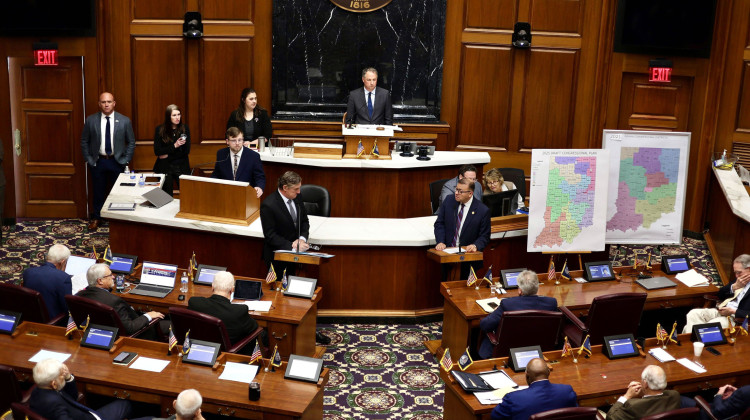Public safety played heavily into the national conversation in 2014, and it factored greatly into the local conversation as a rising murder rate dominated local headlines for much of the year.
But 2014 was also a year for fresh ideas and new approaches. The Indianapolis Department of Public Safety actively engaged the community as it sought new ways to address the city’s crime problem and announced a new data-driven approach to reducing crime aimed at addressing root causes in six of the city’s most troubled neighborhoods.
WFYI's Christopher Ayers spoke with Public Safety Director Troy Riggs shortly before the end of the year about the issues and what he feels his department accomplished in 2014.
CHRISTOPHER AYERS: The first thing I want to ask you about is the increase this year in criminal homicides—the year’s not over yet, but that number is already more than last year’s total. On the other hand, we have some reports that claim other instances of violent crime seem to be trending downward—what exactly is going on there?
TROY RIGGS: One of the things that we’re really concerned about is the amount of people that are coming out of prison with former gun charges in relationship to violent crimes. So, when you look at our homicides this year and last year, you’re going to quickly realize that most of the individuals that were victims in homicides and those that were suspects have criminal pasts.
This year we’ve had 92% of all of our criminal homicide suspects have a criminal past. 83% of our homicide victims have a criminal past. What we’re seeing is, far too often, too many individuals commit a violent crime with a weapon to be arrested by the police department, over and over again, only to be a perpetrator in a homicide down the road. We believe if we have mandatory minimum sentencing, that our homicide rate would drop by at least 20 to 25% overnight.
CA: And that’s something that’s sort of in the hands of the state legislature, right?
TR: It is. And we’ll be going to the state legislature once again to ask for that. That’s been something that’s been very disappointing for our police officers, where they continue to arrest the same individuals, only to see someone commit a homicide. And we need to do a better job of that as we’re using data to track individuals as they reenter society from prison, those that have a propensity to commit violence, but we need some help on the state side as well.
Riggs says another thing many find surprising about Indy’s homicide rate is the number stemming from simple arguments that end with someone dead. Riggs says that a lack of ability to deescalate conflict is one example of many of the more structural and systemic problems in some of Indy’s neighborhoods that give rise to crime—its root causes.
In October, Riggs and Mayor Greg Ballard announced what the department is calling a philosophical shift in how government operates when it comes to addressing public safety concerns. With the help of data gathered from DPS agencies and several area non-profits, the Department of Public Safety analyzed a variety of socio-economic factors, singling out six neighborhoods that need the most attention.
TR: We said, let’s look at this data. Let’s compare this data over the last couple of years, and let’s see where the main issues are in our community. So we did that, and we came up with six areas. These six areas throughout the community are only eight square miles total. That’s 4.7% of the entire population of the city of Indianapolis. That 4.7% of our neighbors and friends live in areas where 27% of the homicides and 30% of the shootings take place.
Additionally in those areas, since we’re looking at all data to have a holistic approach, we know that 14.5% of all of our mental-emotional runs occur within 8 square miles, where only 4.7% of our population runs from 25 to 37%.
Then you start looking at poverty rates. The issues facing juveniles, the issues facing single moms—and, you realize, that in most of these areas, over 80% of the population lack the basic skills to get a good middle-class income job.
We’re focusing there on the root causes of crime. We believe that the police department can do some things to affect crime in the short term, but, if we’re going to have long term success in the city of Indianapolis, we need to be working together collectively on these issue.
CA: With some of these issues running so deep in some of these communities—how do you measure success and how much time has to pass before you start taking those measurements
TR: Well, the first thing we have to do is set some short-term goals. What are the big issues we’re hearing from the community during our community conversations? Some of those have to do with young people—lack of summer jobs, lack of opportunities.
So we need to deal with those in the short term. We have helped raise money through our summer jobs program. I think last year we raised over $32,000 for summer jobs. We’ve had safe havens for young people to go to, and we were able to get potential funders and providers to make sure kids have a safe place to go. Those are things we could do in the short term. Last year when we had our summer jobs program—in that area, we did not have any street robberies or any other crimes that are usually associated with juveniles.
The long-term goals that we’re going to have to set are going to do with mental illness—how are we going to tackle that as a community? Do we need to arrest everybody for minor-type crimes? Can we take them to an engagement center where they’re getting help for dependency issues or their mental illness? So working with the sheriff’s office and prosecutor’s office to try and make that a reality.
Those are some long-term goals. But what we need to do is we need to grow this new philosophy in a deliberate way, a very thoughtful way. So we don’t get overwhelmed by the issues. And that’s one of the things that I hear from the community members—these issues seem to be so entrenched, where do we begin?
And my answer to that is simply—let’s begin in those six areas. If we begin there, and we’re successful, we’re going to start seeing drops in crime rates and drops in homicides over the next two, five and ten years.
Parts of this interview were edited for time and clarity.
You can find the second part in this two-part conversation with DPS Director Troy Riggs here.
 DONATE
DONATE








 Support WFYI. We can't do it without you.
Support WFYI. We can't do it without you.